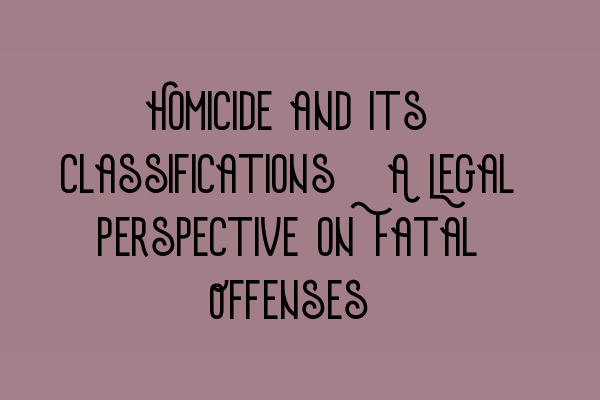Homicide and its Classifications: A Legal Perspective on Fatal Offenses
When it comes to criminal law, few offenses carry the weight and gravity of homicide. Homicide refers to the act of one human being causing the death of another. The legal classification of homicide plays a crucial role in distinguishing between different types of fatal offenses. In this article, we will explore the various classifications of homicide from a legal perspective.
1. Murder
Murder is the most serious form of homicide. It involves the intentional killing of another person with malice aforethought. Malice aforethought refers to the presence of intent to cause death or serious bodily harm. Murder can be further categorized into first-degree murder and second-degree murder.
First-degree murder is premeditated and deliberate, demonstrating a clear intent to kill. This can include situations where the defendant planned the murder in advance or acted with extreme disregard for human life. First-degree murder carries the harshest penalties, including life imprisonment or even the death penalty.
Second-degree murder, on the other hand, does not involve premeditation or specific intent. It occurs in the heat of the moment, often as a result of provocation or sudden rage. While still a serious offense, second-degree murder typically carries lesser penalties than first-degree murder.
2. Manslaughter
Manslaughter is another classification of homicide, distinguished from murder by the absence of malice aforethought. Manslaughter can be classified into two main categories: voluntary manslaughter and involuntary manslaughter.
Voluntary manslaughter refers to killings that occur in the heat of passion, but without premeditation. This can include situations where the defendant was provoked and acted impulsively. Although voluntary manslaughter does not involve premeditation, it is still considered a serious crime.
On the other hand, involuntary manslaughter refers to unintentional killings that occur as a result of reckless behavior or criminal negligence. This can include situations where the defendant acted with disregard for the safety of others, causing the death of another person.
3. Infanticide
Infanticide is a unique classification of homicide that specifically applies to cases involving the killing of a newborn child by its mother. It is important to note that infanticide is a separate offense from murder or manslaughter. This classification recognizes the unique circumstances surrounding childbirth and the potential mental distress experienced by the mother.
Infanticide is typically associated with cases where the mother suffers from postpartum depression or other mental disorders. The law recognizes that the mother may not be fully responsible for her actions due to these circumstances. As a result, the penalties for infanticide are generally less severe than those for murder or manslaughter.
It is crucial to understand the various classifications of homicide to properly evaluate and litigate fatal offenses. If you require legal assistance or representation in a homicide case, it is important to consult with an experienced criminal defense solicitor who specializes in criminal law.
At SQE Criminal Law & Practice Law UK, we have a team of highly skilled solicitors who can provide expert guidance and representation in homicide cases. Our solicitors are well-versed in the intricacies of the law and have a proven track record of success in defending clients charged with homicide offenses.
If you are preparing for the SQE exams, check out our related articles to help you in your preparation:
- SQE 1 Practice Exam Questions
- SQE 1 Practice Mocks FLK1 FLK2
- SQE 2 Preparation Courses
- SQE 1 Preparation Courses
- SRA SQE Exam Dates
For any legal assistance or inquiries, please don’t hesitate to contact SQE Criminal Law & Practice Law UK. Our dedicated team is here to help you with all your legal needs.
